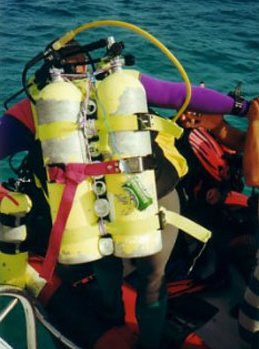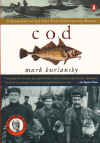Tanks - Recommendations
For their resistance to corrosion, rough handling, and general abuse, and their low price, aluminum tanks are very attractive to rental operations. That doesn't mean you should buy them for yourself.
 |  |  |  | ||
| 66 cu ft ladies | 85 cu ft perfect | 98 cu ft too fat | 135 cu ft ridiculous | 45 cu ft stage | 20 cu ft pony |
The best tanks on the market are were from OMS. These low-pressure ( 2640 psi ) steel tanks are costly but have the best weight and buoyancy characteristics of anything available. The OMS 85's are my favorite because they are almost the exact same weight and dimensions as AL80's, with 10% more rated capacity. They also make a nice slim package when doubled up. For shorter folks and ladies, the OMS 66 is a shorter version of the 85.
These same Faber / OMS tanks are used in Europe at rated pressures up to 3500 psi with no ill effects. They are rated to 4000 psi by the manufacturer, but derated to 2640 by the US DOT. Of course, overfilling a tank like is against the law, and you should never ever do it. ( If their products were not needlessly derated like this, Faber ( Italy ) would put the domestic tank manufacturers right out of business! )
Apart from the extra capacity for deep diving, steel tanks are also superior for shallow shore diving, where the reduced total weight of tank + lead makes crossing a wide beach or climbing up and down rocks much easier. If you do a lot of shore diving, a steel 45 stage bottle would be a good investment. When used as a main, a tank like this has more than enough capacity for a shallow, time-constrained dive, and has virtually the same in-water buoyancy characteristics as a full-sized tank, with nearly half the out-of-water weight.
Not all steel tanks are created equal. I have heard repeatedly of other manufacturers' high-pressure steel tanks that fail their first hydro! That's an expensive piece of junk. Based on what I hear from 'old-timers', OMS cylinders have no such problems and will last forever if properly cared for. More and more of the local shops are carrying OMS tanks, but if you can't get them locally, you can mail-order them at very good rates from Leisure Pro. Don't settle for second-best.
June 2007 - this page has gotten rather dated. The OMS LP85s are still theoretically in production, but in practice unavailable. The LP line of tanks has been supplanted by a new line of HP tanks. The new HP100 is nearly identical in all specifications, but rated to 3440 psi. For all intents and purposes, the LP85 and the HP100 are equivalent. The HP tank is DIN-only, but is finally rated for its true working pressure, whereas the LP tank required some wink-wink-nudge-nudge to get a real fill.
I see a lot of shops nowadays selling manifolded doubles to beginners, claiming that this way they won't have to "upgrade" later. In fact, this is a very dangerous setup for an inexperienced diver, and has resulted in a number of accidents and more than a few fatalities. There is only one purpose for double tanks - decompression - the one thing an inexperienced diver should avoid. Beginners should instead start out with single tanks ( and a pony bottle, of course ) and build up their abilities by doing a great many safe, conservative, no-decompression dives before they even think about doing the kind of diving that would actually require the use of double tanks.
Most recreational diving in New Jersey or anywhere in the world can be accomplished with a single tank, and with experience, most people will find that they never want or need to "upgrade" to doubles. In fact, I know a number of people who bought expensive doubles rigs on the recommendation of their LDS, only to break them down into singles after one season.
It is unforgivably irresponsible for a dive shop to recommend and sell advanced equipment to inexperienced divers, and it is foolishly dangerous for beginners to buy equipment that is beyond their abilities and experience to safely use.
DIR
The only allowed DIR setup is double steel tanks with permanent stainless-steel bands and isolation manifold. There are other details, and some variance is allowed in tank size to suit the individual diver, but otherwise, it is implicitly assumed that this setup will cover all situations. It does not.
It is almost comical to see someone trying to climb down the rocks at Shark River with double tanks on, or shlep a huge set of doubles down the hill at Dutch Springs ( well, ok, most of those are Trimix students. ) Even in the open ocean, there are many situations where double tanks are unsuitable. The extra drag slows you down tremendously in the water, and the extra weight can turn re-boarding the boat in rough seas into a real adventure.
For recreational diving, double tanks should be considered a last resort for big people who use a lot of air and can easily manage the extra weight. I have seen many smaller people and women staggering under the weight of even a small set of DIR doubles that they don't need, and scratch dives on rough days because they don't think they can make it back into the boat! In most situations, you are better off with a single tank and pony bottle.
I have presented a great many flexible options in tank selection and rigging above. DIR presents you with one option. It may be the one for you, but more likely it is not. Think about where you want to dive, what you want to achieve, and what you need, rather than mindlessly jumping into an expensive and limiting DIR rig.
DIR also forbids tank boots. All I can say about that is don't even think about bringing a set of round-bottomed tanks on a dive boat. For the real-world - use tank boots.
The real hard-core DIR material states that steel tanks should only be used for cave diving, and only aluminum tanks should be used for open water, because their buoyancy assures that in an emergency you will be able to reach the surface with your regulation steel backplate on. A better and much cheaper idea would be to lose the steel backplate and pick up some ditchable lead weights.


